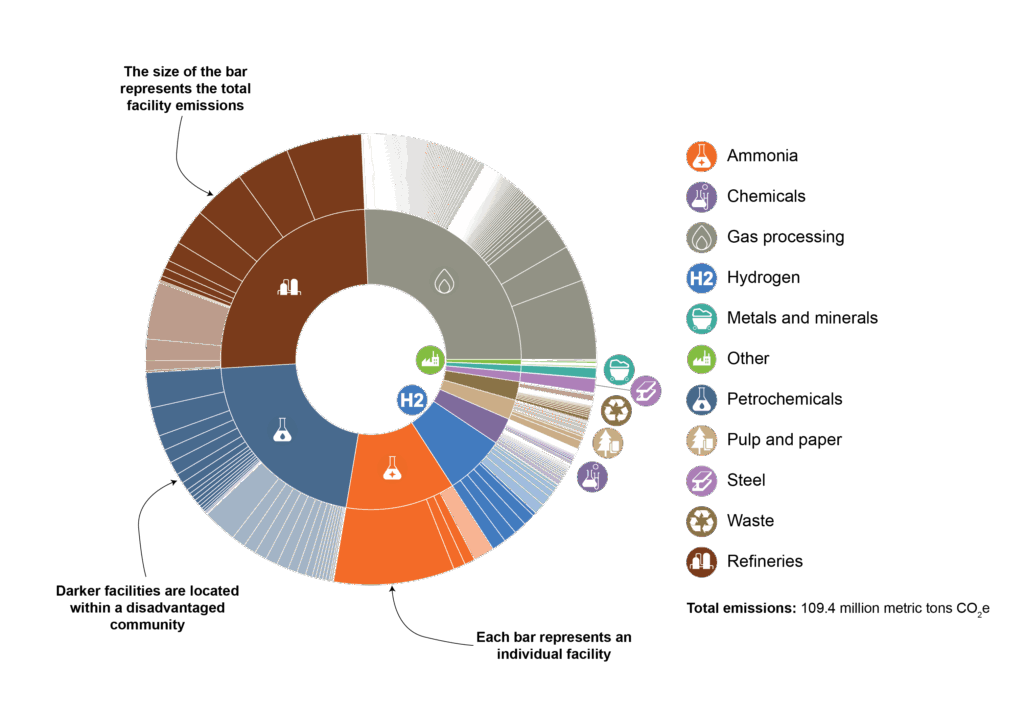Louisiana
Louisiana generates more industrial emissions than any state except neighboring Texas. Three sectors are responsible for the bulk of emissions: petroleum and natural gas systems, non-fluorinated chemicals, and refineries. The state’s sixteen refineries, which refine approximately one-sixth of the nation’s oil, account for nearly 25 percent of industrial emissions. Petrochemicals, ammonia, and hydrogen account for most chemical production. Chemical production is concentrated in the corridor between New Orleans and Baton Rouge. Oil and gas extraction takes place both offshore and onshore.

- This map shows the top 20 emitters, coded by industrial sector. The size of the circles corresponds to emissions: the larger the circle, the higher the emissions.
- Disadvantaged communities (as determined by the federal government) are shaded blue.

- The inner circle provides a visual representation of the share of emissions generated by each industrial sector.
- The outer circle also indicates the share of a sector’s emissions generated in disadvantaged communities.
STATE ENERGY POLICY:
Examining a state’s broader energy policy landscape is helpful when considering policies to support industrial innovation. Louisiana has established executive greenhouse gas emissions targets. Louisiana has not established an electricity portfolio standard or a clean heat standard. While these formal commitments are not prerequisites for innovative industrial policy, they can provide a supportive framework. In addition, streamlining permitting and establishing an efficient, transparent appeals process that engages local communities early while giving clarity and assurances to project developers are key components of effective state energy policy. Discussions around innovative industrial policy present an opportunity for broader conversations about state energy policy to ensure a mutually reinforcing strategy.
LEGISLATIVE context & opportunity:
Let us know if you are aware of additional legislation advancing industrial innovation in Louisiana that should be featured. The context below is not exhaustive and serves as an example of recent policies and programs and where there may be future opportunities:
- Class VI Primacy: Louisiana has been granted Class VI primacy, shifting the regulatory body for carbon capture and sequestration from the US Environmental Protection Agency to the state. States will Class VI primacy have the authority to manage CCS projects and streamline the permitting process, providing additional clarity for developers and investors. This will likely increase the opportunities and pace at which Louisiana can deploy carbon capture as a technology to reduce industrial emissions.
- HyVelocity Gulf Coast Hydrogen Hub: Louisiana and Texas are part of HyVelocity. Independent of the outcome of the regional hubs, there is strong interest in building a clean hydrogen economy in this region to reduce emissions across hydrogen production, oil and gas development, and industrial manufacturing.
- Carbon management technologies are another opportunity to reduce industrial emissions in the state. Learn more about the economically feasible subsectors in Louisiana and facilities that qualify for the federal 45Q tax credit.
- A factsheet by the Renewable Thermal Collaborative identifies electrification of Louisiana’s ammonia, methanol, and pulp and paper subsectors as opportunities to reduce emissions significantly.
Explore recent legislation in Louisiana and all 50 states by clicking on a specific year: 2025 legislation, 2024 legislation, 2023 legislation.
